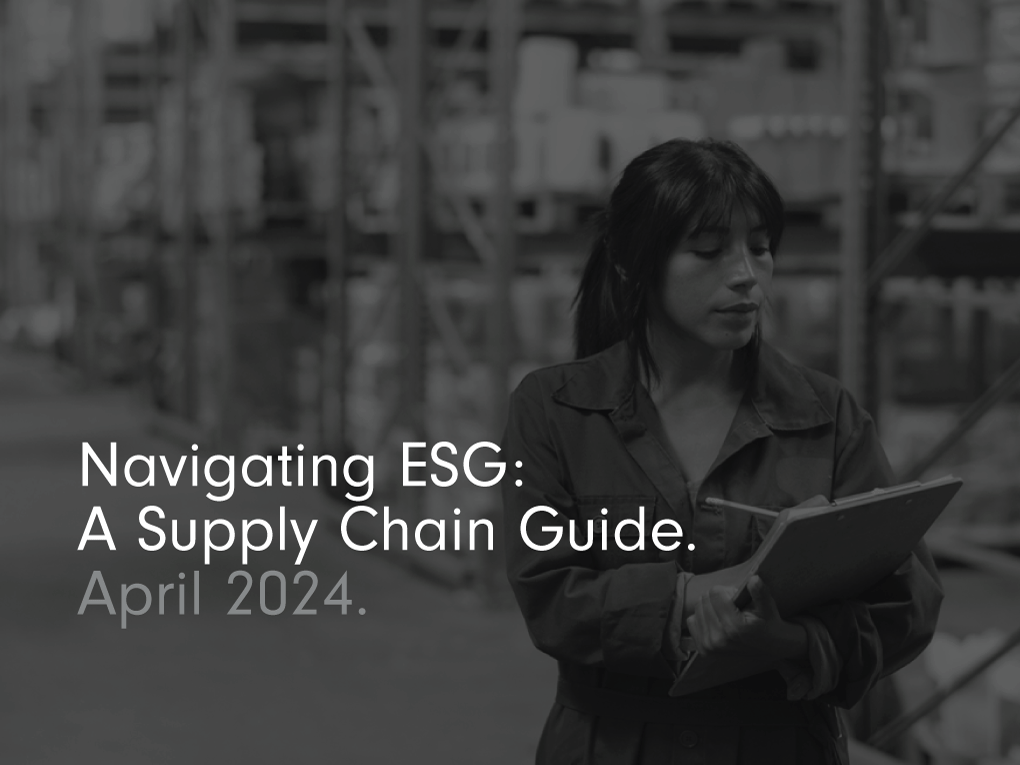Navigating ESG: A Supply Chain Guide to Top-tier Compliance.

In an era where corporate responsibility speaks volumes, the principles of Environmental, Social, and Governance (ESG) have risen to the top of organisational strategy.
The supply chain industry demonstrates this clearly. It involves the complex coordination of global logistics and ethical practices. These are now considered a necessity rather than just a trend. For supply chain managers and compliance officers, ESG is more than just meeting requirements – it’s about transforming business operations for a sustainable future.
Environmental, Social, and Governance considerations increasingly shape consumer preferences, investor priorities, and regulatory frameworks, compelling businesses to reevaluate their end-to-end supply chain. This article provides a comprehensive roadmap for navigating the challenging terrain of compliance.
Understanding the Depth of ESG in the Supply Chain.

Before diving into the specifics of compliance strategies, it’s crucial to understand the core of what ESG stands for. ESG is a range of activities, guidelines, and practices to ensure environmental sustainability, promote social responsibility, and uphold strong corporate governance. Recognising the diverse nature of ESG is the first step towards building a comprehensive compliance framework.
ESG compliance in the supply chain is multi-dimensional. It involves every stakeholder in the supply chain—from raw material providers to manufacturers, distributors, and retailers—abide by the industry’s highest standards. The collective compliance of these entities paints a comprehensive picture of a company’s ESG performance.
The link between sustainability and business success underpins the emphasis on ESG. High performers are not only better positioned for risk management but also to capitalise on emerging market opportunities. Understanding ESG principles is key for supply chain professionals. Following these principles can improve your company’s reputation, provide easier access to money, and attract more customers.
Navigating ESG Compliance Challenges.

ESG compliance within the supply chain is full of unique challenges, requiring innovative thinking and steadfast commitment. Some key challenges include:
Global Compliance Disparities.
The supply chain industry operates globally where regulations and cultural expectations vary widely. Managing these whilst maintaining high compliance standards is a delicate balancing act.
Transparency and Traceability.
Consumers and stakeholders demand unprecedented levels of transparency. Supply chain traceability is, therefore, a non-negotiable aspect of achieving ESG compliance.
Ethical Engagement Across Tiers.
Directors across levels frequently face hurdles in establishing clear and effective lines of communication. Ensuring ethical engagement throughout every tier requires a blend of diplomatic skill and strategic insight.
Continuous Improvement.
Goals are not static. Achieving and maintaining compliance requires a culture of continuous improvement and agility in response to changing regulatory landscapes and stakeholder expectations.
Best Practices for ESG Excellence.

ESG compliance is a marathon, not a sprint. Here are several best practices and actionable tips to help you foster ESG excellence within your supply chain:
Sustainable Sourcing Strategies.
- Foster long-term relationships with suppliers committed to ESG principles.
- Integrate environmental impact assessments into supplier selection processes.
- Engage suppliers in mutual sustainability goals, incentivising compliance through partnership programs.
Reducing the Carbon Footprint.
- Optimise transportation and logistics operations to reduce greenhouse gas emissions and minimise environmental impact.
- Invest in renewable energy sources and technologies that support a low-carbon supply chain.
- Evaluate the lifecycle impact of products, from production to disposal, to identify areas for carbon reduction.
Upholding Fair Labor Practices.
- Regularly audit labour conditions across the supply chain, ensuring compliance with international labour standards.
- Implement a zero-tolerance policy for child labour, forced labour, and discrimination.
- Provide workers with the necessary protections, training, and fair wages to foster a dignified working environment.
Corporate Governance and Transparency.
- Integrate ESG policies into every facet of the supply chain operation.
- Improve corporate governance through robust oversight, accountability mechanisms, and a clear reporting framework.
- Develop and communicate comprehensive ESG reports to stakeholders, demonstrating a commitment to transparency.
Leveraging Technology to Streamline ESG Compliance.

The marriage of technology and ESG compliance has unlocked new frontiers within the supply chain industry. Sophisticated Warehouse Management Systems (WMS) can now provide near real-time data on inventory, allowing for smarter inventory control, reducing waste, and bolstering sustainability.
Furthermore, blockchain technology has emerged as a powerful tool for enhancing supply chain transparency and traceability. It enables recording every transaction and movement within the supply chain, offering a record of provenance and compliance.
Leveraging advanced technologies is instrumental in achieving ESG objectives but also pivotal in differentiating your supply chain as a sustainable leader in the industry.
Navigating Regulatory Changes and Consumer Demand.

The ESG pillar within the supply chain industry is not in stasis. Regulatory changes continue to evolve, often reflecting the growing focus on sustainability efforts. Supply chain professionals need to remain agile and responsive to such shifts, embedding adaptability into their compliance strategies.
Consumer demand for ethical and sustainable products is increasing. This forces companies to inject their supply chains with ESG factors or risk losing market share and focus on corporate social responsibility.
Supply chain professionals need to stay ahead of trends, using ESG to meet regulations and stand out in a market that values social responsibility.
Conclusion: ESG as the New Supply Chain Standard.

In conclusion, ESG compliance stands as the new standard for supply chain operations. The path to achieving excellence is arduous, marked with complex challenges and shifting paradigms.
But for those who follow these rules, the rewards are obvious. For those who follow these rules, the rewards are clear. They have a better reputation.
They spend less money. They find it easier to get funding. They help make the world more environmentally friendly.
The time to act is now. To improve the supply chain, follow the best practices we’ve discussed. Use technology effectively. Stay committed to ESG goals. By doing these things, you can lead the way.
Remember, ESG is not a destination; it is an ongoing commitment to the planet, people, and prosperity. It is an opportunity to redefine what it means to be a modern, responsible corporate citizen.